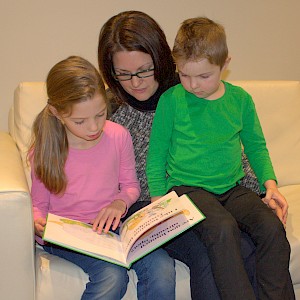Students with language difficulties can benefit from support to help them communicate and learn at home and school. A formal language assessment by a qualified and experienced speech pathologist will provide specific strategies for a student’s individual needs. Here are some ideas which may be helpful:
Pre-school and junior primary students.
- Use simple instructions. Use simple words and break down longer instructions into a series of steps.
- Repeat important information. Get your child’s attention. Give the important points clearly. Repeat them and ask your child to repeat them back to you.
- Use objects, pointing, gestures or pictures to help get your message across.
- Show your child what to do and show them what the end product will look like.
- Give your child lots of opportunities to hear and learn language. Look at books and talk about them together. Talk about what you are doing as you go through daily tasks. Encourage your child to talk to you about what they are doing.
- Use simple questions. Ask about things that they can see and are doing right now. Be careful with questions such as “Why?” or “What will happen next?” as they may be too difficult.
- Teach good listening behaviours.

- Legs still
- Hands in Lap
- Look at person talking
- Lips quiet
- Listen
- Sit your child away from noises and distractions when learning. At school he/she should be sitting facing the teacher with his/her back to as many other children as possible. At home turn off the TV and other distractions for learning times and homework.
- Model correct sentences for your child when they make an error and emphasise the corrected word.
- Use some new words when talking with your child and repeat the new words many times. Books and lotto boards are a way of developing new words. It is important to develop a range of word types such as verbs (action words), adjectives (yellow, big) position words (in, on, under) and adverbs (fast, slow).
Middle Primary and Senior Students
Children with language disorder learn better by seeing than hearing so use things your child can see as much as possible, such as :
- Maps, diagrams, pictures or video.
- A list of important words.
- A plan of the steps or an outline of the project.
- Hands-on activities and showing as well as telling what to do.
Help your child understand by:
- Teaching new words and concepts before starting new topics.
- Marking important words and concepts with a highlighter.
- Making lists of important words.
- Linking new information to known information.
- Allowing extra time to learn new information or concepts.
- Making a plan of work before starting.
- Talking through information before writing it down.
- Following the steps of brainstorming, planning, writing then checking work.
- Trying other ways of presenting work of such as talks, models, posters, PowerPoint presentations, videos or tape recordings.
Help your child use correct sentences and grammar by:
- Encouraging them to read their own work out loud. This often makes grammatical errors easier to notice.
- Encouraging them to do a rough copy then check their work, or read to another person and ask them to help check it.
- Using a word processor with spelling and grammar checks.
Help your child work independently by:
- Checking their own work for spelling and grammar as well as meaning before asking for help.
- Using a dictionary to check new words and a thesaurus to find new words.
- Requesting help when needed or using a buddy.
Related Blog Posts
If you liked this post you may also like:
Self esteem
Beginning questions
Christmas and ASD
Using MR/MRS POTATO HEAD To Grow



